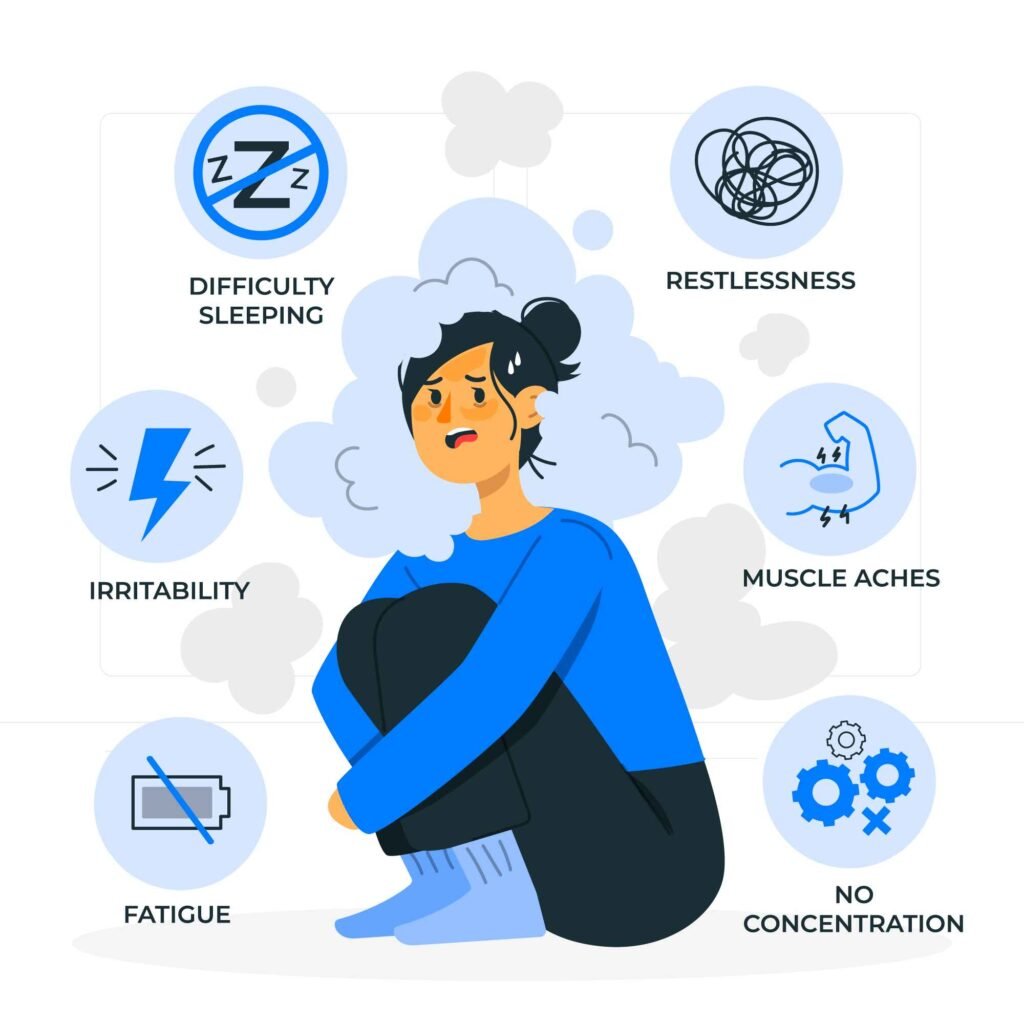
The Science Behind Breathing Techniques for Stress Management
Understanding Stress and Its Impact on the Body
What is Stress?
Stress is the body’s natural response to perceived threats or challenges. When faced with stressors, the body activates the “fight-or-flight” response, leading to the release of stress hormones such as cortisol and adrenaline. While this response can be helpful in short bursts, chronic stress can harm physical and mental health.
Effects of Chronic Stress on the Body
- Physical Health: Chronic stress can lead to increased blood pressure, a weakened immune system, and higher risks of heart disease.
- Mental Health: Prolonged stress contributes to anxiety, depression, and cognitive decline.
- Sleep Disruptions: Stress often interferes with sleep quality, exacerbating fatigue and irritability.
Why Breathing Techniques Work
Breathing is a unique physiological process. Unlike other bodily functions, it can be controlled both consciously and unconsciously. This dual control allows breathing techniques to act as a bridge between the mind and body, helping to regulate stress responses effectively.
The Science Behind Breathing and Stress Reduction
How Breathing Influences the Nervous System
The autonomic nervous system (ANS) has two branches:
- Sympathetic Nervous System (SNS): Activates the “fight-or-flight” response during stress.
- Parasympathetic Nervous System (PNS): Promotes the “rest-and-digest” state, fostering relaxation.
Deep and controlled breathing stimulates the vagus nerve, a key component of the PNS. This activation slows the heart rate, lowers blood pressure, and promotes a sense of calm.
The Role of Oxygen and Carbon Dioxide Balance
Proper breathing ensures the optimal exchange of oxygen and carbon dioxide. Stress often leads to shallow or rapid breathing, causing an imbalance that can result in dizziness, fatigue, or heightened anxiety. Breathing techniques restore balance, improving both physical and mental states.
Research Supporting Breathing Techniques
- Heart Rate Variability (HRV): Studies have shown that slow, controlled breathing improves HRV, an indicator of a well-regulated nervous system.
- Reduced Cortisol Levels: Research suggests that regular practice of breathing techniques lowers cortisol levels, reducing the physiological impact of stress.
- Enhanced Brain Function: Breathing exercises increase oxygen supply to the brain, improving focus, memory, and decision-making skills.
Top Breathing Techniques for Stress Management
1. Diaphragmatic Breathing (Belly Breathing)
Diaphragmatic breathing involves deep breaths that fully engage the diaphragm, promoting relaxation.
- How to Practice:
- Sit or lie down in a comfortable position.
- Place one hand on your chest and the other on your stomach.
- Breathe deeply through your nose, ensuring your stomach rises.
- Exhale slowly through your mouth.
- Repeat for 5–10 minutes daily.
- Benefits: Reduces heart rate, enhances oxygen exchange, and lowers stress.
2. Box Breathing (Square Breathing)
Popular among Navy SEALs, box breathing is a structured technique designed to calm the nervous system.
- How to Practice:
- Inhale for a count of four.
- Hold the breath for a count of four.
- Exhale for a count of four.
- Hold for another count of four.
- Repeat for 4–5 cycles.
- Benefits: Improves focus, reduces anxiety, and stabilizes emotional responses.
3. 4-7-8 Breathing
Developed by Dr. Andrew Weil, this method combines deep breathing with mindfulness.
- How to Practice:
- Inhale quietly through the nose for 4 seconds.
- Hold the breath for 7 seconds.
- Exhale forcefully through the mouth for 8 seconds.
- Perform for up to 4 breaths initially, increasing as you become comfortable.
- Benefits: Promotes deep relaxation, aids in falling asleep, and eases stress.
Physiological Changes During Breathing Exercises
Breathing techniques activate the baroreceptor reflex, a mechanism that stabilizes blood pressure. This reflex enhances the body’s ability to remain calm under stress, making breathing exercises particularly effective for immediate relief.
Mental Benefits of Breathing Techniques
- Mindfulness: Focusing on the breath anchors the mind in the present moment.
- Reduced Overthinking: Controlled breathing shifts focus away from racing thoughts.
- Enhanced Emotional Regulation: Breathing exercises improve the ability to manage emotional responses during challenging situations.
Creating a Stress-Free Environment for Breathing Practices
To make the most of breathing techniques, it’s essential to create a space that fosters relaxation. Here’s how you can set the stage:
- Quiet Space: Find a calm area where distractions are minimized.
- Comfortable Position: Sit or lie in a position that allows you to breathe deeply without restriction.
- Set a Timer: Allocate 5–10 minutes daily to focus solely on your breathing practice.
By cultivating a peaceful setting, you’re more likely to stick to a consistent routine and reap the benefits of deep breathing.
When and Where to Practice Breathing Techniques
Breathing exercises can be integrated seamlessly into your daily routine. Some ideal moments include:
- Morning: Start your day with 5 minutes of diaphragmatic breathing to set a positive tone.
- During Stressful Situations: Use box breathing or 4-7-8 breathing to manage acute stress or anxiety.
- Before Bed: Practice slow breathing to wind down and prepare your body for restful sleep.
- Breaks at Work: Step away for a few moments and engage in mindful breathing to refresh your mind.
Incorporating these techniques into daily activities ensures that stress relief becomes a natural part of your life.
The Long-Term Benefits of Consistent Breathing Practices
Consistency is key when it comes to maximizing the impact of breathing techniques. Over time, regular practice can lead to:
- Improved Heart Health: By lowering blood pressure and reducing stress, breathing exercises contribute to cardiovascular wellness.
- Enhanced Resilience: Regular use of these techniques strengthens your ability to cope with future stressors.
- Mental Clarity: A calmer mind leads to better focus, creativity, and decision-making abilities.
- Better Emotional Balance: Consistent breathing practices promote emotional stability and reduce the intensity of negative emotions.
Combining Breathing Techniques With Other Stress-Relief Strategies
1. Pairing Breathing With Meditation
Meditation enhances the effectiveness of breathing techniques by fostering mindfulness and self-awareness. To combine the two:
- Start with a simple breathing exercise like diaphragmatic breathing.
- Shift your focus to a calming mantra, word, or your breath’s natural rhythm.
This combination deepens relaxation and strengthens your ability to remain present.
2. Yoga and Breathing Practices
Yoga incorporates breath control (pranayama) into physical movements, creating a holistic stress-relief practice. Common breathing techniques in yoga include:
- Alternate Nostril Breathing: Balances energy levels and calms the mind.
- Ujjayi Breathing (Victorious Breath): Synchronizes breath with movement, enhancing focus and relaxation.
Incorporating yoga into your routine can amplify the benefits of breathing exercises.
3. Physical Activity and Breathing
Engaging in physical activities like walking or stretching while focusing on your breath can improve overall relaxation. Pay attention to rhythmic breathing during exercise to enhance endurance and maintain calmness.
Mindfulness and Breathing: A Powerful Duo
Mindfulness complements breathing techniques by helping you cultivate awareness of your thoughts and feelings without judgment. When practiced together, these tools create a powerful approach to managing stress.
- Mindful Breathing Exercise: Sit comfortably, close your eyes, and focus on the sensation of your breath entering and leaving your body. When your mind wanders, gently bring it back to your breath.
This practice not only reduces stress but also increases your ability to handle challenges with a clear mind.
Technology and Breathing Techniques
Modern technology has made stress management more accessible. Apps and devices can guide you through breathing exercises and track your progress. Popular options include:
- Breathing-focused apps that provide guided exercises and visual cues.
- Wearable devices that monitor your heart rate and stress levels, offering real-time feedback.
Using these tools can make it easier to stay consistent and measure the impact of your efforts.
The Science of Immediate Stress Relief
One of the most appealing aspects of breathing techniques is their ability to provide immediate relief from stress. When you focus on deep, controlled breathing, your body reacts by:
- Lowering Cortisol Levels: This reduces feelings of anxiety and tension.
- Slowing Heart Rate: A slower heart rate signals the body to shift from a state of stress to relaxation.
- Improving Oxygen Flow: Enhanced oxygen delivery to the brain boosts mental clarity and energy.
These physiological changes explain why even a few minutes of breathing exercises can have a noticeable calming effect.
Building a Habit of Breathing Practices
To turn breathing techniques into a lasting habit:
- Start Small: Begin with just 2–3 minutes daily and gradually increase the duration.
- Set Reminders: Use alarms or app notifications to prompt you to practice.
- Track Progress: Maintain a journal to note how you feel before and after each session.
By committing to these practices, you’ll create a sustainable routine that supports long-term stress management.
Real-Life Stories of Stress Relief Through Breathing
Hearing how others have benefited from breathing techniques can inspire your journey. For example:
- Sara, a busy professional, overcame workplace anxiety by practicing 4-7-8 breathing before important meetings.
- Michael, a father of three, found that daily diaphragmatic breathing helped him stay calm during chaotic mornings.
- Emma, a college student, used box breathing to reduce test anxiety and improve focus.
These stories highlight the universal applicability of breathing exercises across different lifestyles and challenges.
Common Misconceptions About Breathing Exercises
While breathing techniques are widely regarded as simple and effective, misconceptions often prevent individuals from fully embracing their benefits. Let’s debunk some myths:
- “Breathing Exercises Are Only for Meditation Enthusiasts.”
Breathing techniques are not exclusive to meditation practices. They are practical tools accessible to everyone, regardless of lifestyle or beliefs. - “They Don’t Work for Severe Stress.”
Scientific studies prove that controlled breathing can significantly reduce even severe stress by regulating the autonomic nervous system. - “You Need Special Training to Do It Right.”
Most breathing techniques are easy to learn and require no prior experience. With consistent practice, anyone can master them.
How to Stay Consistent With Breathing Practices
Consistency can be challenging, especially with a busy schedule. Here’s how to stay on track:
- Create a Routine: Attach breathing exercises to existing habits, such as starting your day or winding down at night.
- Set Achievable Goals: Start with short sessions and gradually increase the duration.
- Stay Patient: Results may not be immediate, but persistence pays off as your body adapts to the practice.
The key is to view breathing exercises as a long-term investment in your mental and physical health.
Personalizing Your Breathing Practices
Not all techniques work the same for everyone. Experiment with different approaches to find what suits you best:
- If you prefer structure, box breathing offers a reliable framework.
- For deeper relaxation, diaphragmatic breathing might be ideal.
- If you struggle with sleep, the 4-7-8 technique can help you unwind before bed.
Tailoring these practices to your preferences ensures a more enjoyable and effective experience.
Advanced Techniques for Stress Management
1. Resonance Breathing (Coherent Breathing)
This advanced method involves slowing your breathing to 5-6 breaths per minute to optimize heart rate variability (HRV).
- How to Practice:
Inhale for 5 seconds, then exhale for 5 seconds, maintaining a steady rhythm for 10 minutes. - Benefits: Promotes a state of coherence between the heart and brain, reducing anxiety and improving emotional stability.
2. Breathing Paired With Visualization
Visualization enhances the calming effects of breathing exercises by engaging the mind.
- How to Practice:
While practicing deep breathing, imagine yourself in a serene environment, like a beach or forest. Synchronize your breath with the imagery for enhanced relaxation. - Benefits: Helps in grounding your thoughts and reducing intrusive stress-related patterns.
3. Sudarshan Kriya
A powerful yogic breathing practice, Sudarshan Kriya involves rhythmic breathing patterns that detoxify the body and calm the mind.
- How to Practice:
This technique requires guidance from a trained practitioner for safe and effective execution. - Benefits: Scientifically proven to reduce cortisol levels, enhance sleep quality, and alleviate symptoms of anxiety and depression.
Enhancing Breathing Techniques With Aromatherapy
Combining breathing exercises with aromatherapy can amplify stress-relief benefits. Essential oils like lavender, chamomile, and eucalyptus can:
- Encourage deeper breaths by creating a calming environment.
- Stimulate the relaxation response by engaging the olfactory system.
Simply diffuse these oils in your practice space or apply them lightly to your wrists before starting.
Breathing Techniques for Specific Stress Scenarios
1. Managing Workplace Stress
In high-pressure work environments, quick breathing exercises can offer immediate relief. Techniques like box breathing can be practiced discreetly at your desk to help regain focus and composure.
2. Coping With Social Anxiety
Controlled breathing can be a lifeline during socially stressful situations. Slow and steady diaphragmatic breathing helps lower heart rate and prevent the physical symptoms of anxiety, such as trembling or sweating.
3. Handling Panic Attacks
For those prone to panic attacks, grounding techniques paired with breathing exercises can restore a sense of control. Try the 5-5-5 method: inhale for 5 seconds, hold for 5 seconds, and exhale for 5 seconds.
Supporting Stress Management With Lifestyle Changes
Breathing techniques are even more effective when paired with healthy lifestyle choices, such as:
- Balanced Diet: Nutrient-rich foods like omega-3s and magnesium support the body’s stress response.
- Regular Exercise: Physical activity naturally reduces stress hormones and complements breathing practices.
- Adequate Sleep: Restorative sleep enhances the body’s ability to handle stress.
When combined with breathing exercises, these habits create a robust foundation for stress resilience.
Transforming Your Life With Breathing Practices
The Holistic Benefits of Breathing Techniques
Regular practice of breathing exercises not only reduces stress but also fosters overall well-being. The holistic benefits include:
- Improved immune function, making you less susceptible to illness.
- Better emotional regulation, allowing you to navigate challenges with ease.
- Enhanced self-awareness, leading to greater mindfulness and inner peace.
A Lasting Tool for Stress Relief
Breathing techniques are more than just a temporary fix; they are a lifelong tool for managing stress. By integrating them into your daily routine, you’ll cultivate a state of balance and resilience that supports your long-term mental and physical health.



